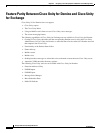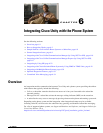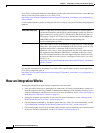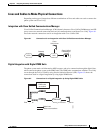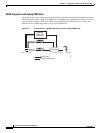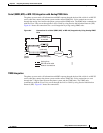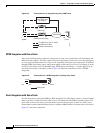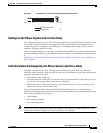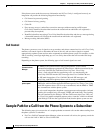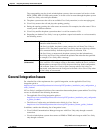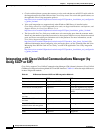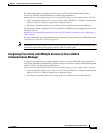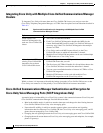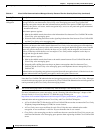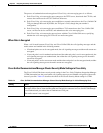
6-8
Design Guide for Cisco Unity Release 5.x
OL-14619-01
Chapter 6 Integrating Cisco Unity with the Phone System
Sample Path for a Call from the Phone System to a Subscriber
If the phone system sends the necessary information and if Cisco Unity is configured correctly, an
integration can provide the following integration functionality:
• Call forward to personal greeting
• Call forward to busy greeting
• Caller ID
• Easy message access (a subscriber can retrieve messages without entering an ID because
Cisco
Unity identifies the subscriber based on the extension from which the call originated; a
password may be required)
• Identified subscriber messaging (Cisco Unity identifies the subscriber who leaves a message during
a forwarded internal call, based on the extension from which the call originated)
• Message waiting indication (MWI)
Call Control
The phone system uses a set of signals to set up, monitor, and release connections for a call. Cisco Unity
monitors call control signals to determine the state of the call, and uses these signals to respond
appropriately to phone system actions and to communicate with the phone system. For example, a caller
who is recording a message might hang up, so Cisco
Unity detects that the call has ended and stops
recording.
Depending on the phone system, the following types of call control signals are used:
Sample Path for a Call from the Phone System to a Subscriber
The following steps give an overview of a sample path that an external call can take when traveling from
the phone system to a subscriber.
1. For Cisco Unified Communications Manager, when an external call arrives, the gateway sends the
call over the LAN or WAN to Cisco Unified
CM.
Cisco Unified
Communications
Manager
For Skinny Call Control Protocol (SCCP) integrations, Cisco Unified
Communications Manager generates SCCP messages, which are translated by the
Cisco
Unity-CM TSP into TAPI that Cisco Unity uses. Cisco Unity
actions—such as hook flash for transferring calls—are translated by the
Cisco
Unity-CM TSP into the SCCP messages that Cisco Unified CM uses.
For SIP trunk integrations, Cisco Unified CM sends SIP messages, and
Cisco
Unity sends SIP responses when a call is set up or terminated.
Circuit-switched
phone system
For PIMG/TIMG integrations, the phone system sends messages to the PIMG or
TIMG units, which send the applicable SIP messages to Cisco
Unity. Cisco Unity
sends SIP responses when a call is set up or terminated, and the PIMG or TIMG
units communicate with the phone system.
For voice card integrations, the phone system generates and responds to in-band
signaling (for example, busy, disconnect, DTMF, and hook flash). The signaling
tones are translated by the Dialogic TSP into TAPI events that Cisco
Unity can
use. Cisco
Unity makes a telephony request such as “transfer,” which is translated
by the Dialogic TSP into the signal (hook flash) that the phone system can use.



